While the sinking of the Eilat is often singled out as the origin of modern anti-missile systems, this isn't really true. The first SAM systems were built to plug the most glaring hole in naval air defense and give ships a way to shoot down high-altitude attackers, but as soon as these were in service, attention turned to something that could protect against sea-skimming aircraft or missiles. The 20mm and 40mm guns that had provided close-in defense during WWII were inadequate in the jet age, and the new system would need to be able to react quickly, have a high kill probability and be light and cheap enough to fit on every ship. Initially, the USN planned to fill this role with the Sea Mauler, based on a short-range air defense system being developed by the US Army. This would use an automatic fire-control system, with targets simply designated by the operator, and beam-riding fire control that would let it be used close to the sea's surface. Unfortunately, this weapon was well ahead of its time, and various technical and programmatic problems led to its cancellation in 1965, leaving its potential users scrambling for a replacement.
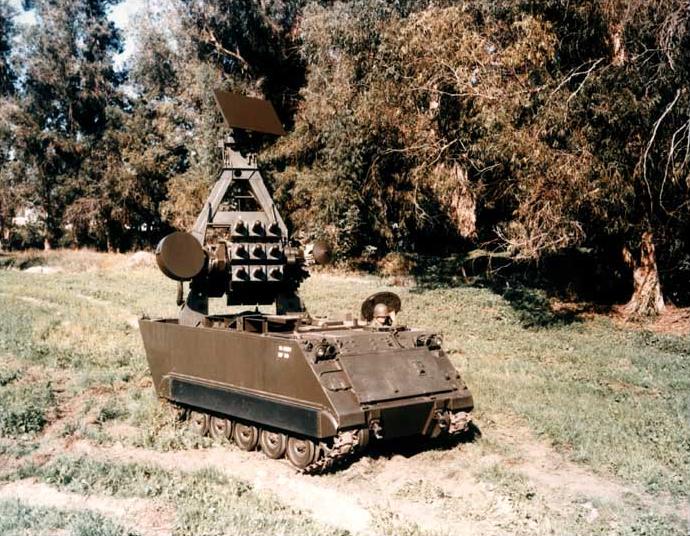
The land-based Mauler prototype
The Army decided on a combination of the M61 Vulcan 20mm gatling gun and the AIM-9 Sidewinder for its short-range air defense efforts, but neither system was immediately suited to the Navy's needs. The Sidewinder took too long to lock on, and the models available at the time were only able to lock on to targets flying away from them, a particular problem when trying to defend oneself against incoming missiles.1 Vulcan had the potential to be useful, but it would obviously be a last-ditch weapon and it would take a while to build the systems to make it effective.
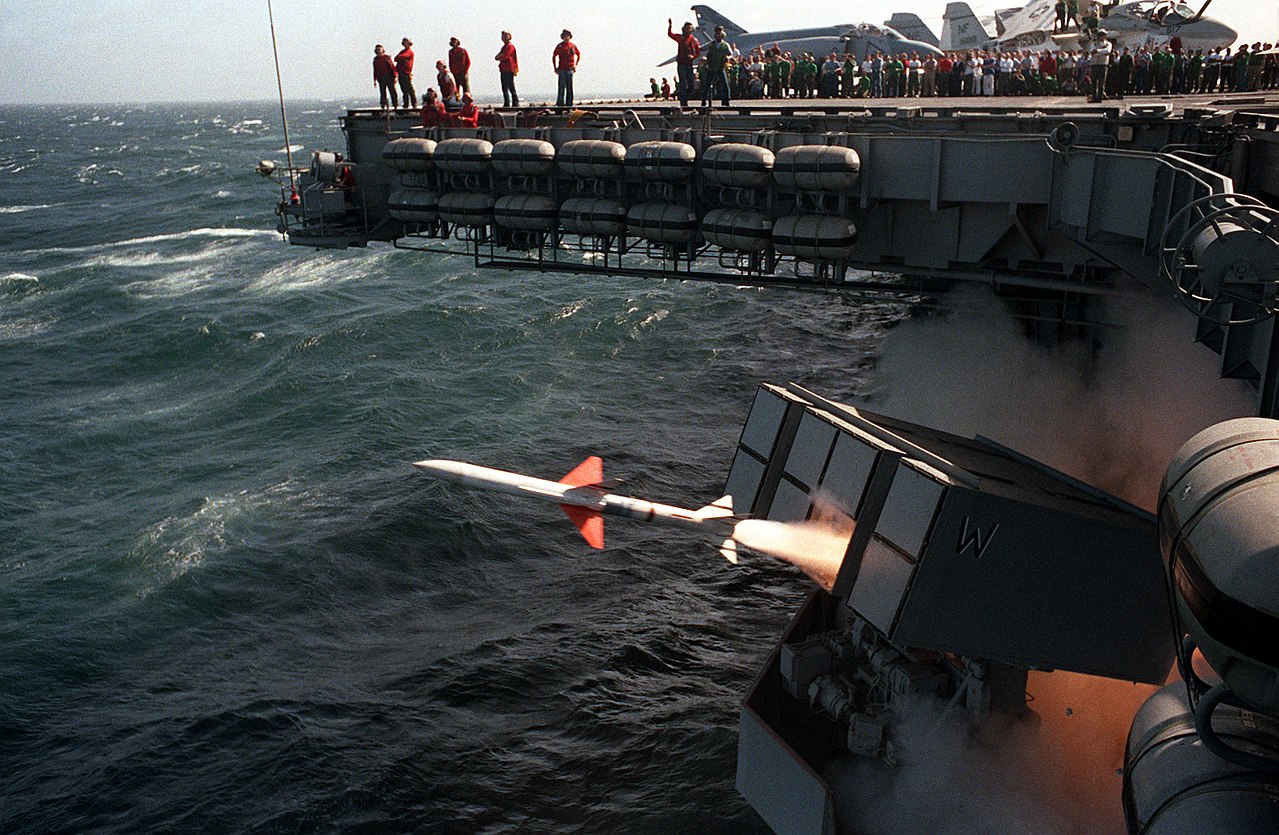
An early Sea Sparrow launches from Midway
Instead, the Navy turned to its other air-to-air missile, the AIM-7 Sparrow. Unlike the Sidewinder, it used semi-active radar homing, allowing it to target incoming missiles, and it could be adapted very quickly for use at sea. The missile itself could be used essentially as-is, fired from the box launcher developed for ASROC. Guidance would be provided by a manually-aimed radar illuminator, with the beams set wide enough to compensate for any imprecision in the operator's pointing and the missile set to guide on a doppler-shifted signal to discriminate the target from sea clutter, thanks to receivers on the rear fins that would pick up the signal from the illuminator. This system, known as Basic Point Defense Missile System (BPDMS) was finalized in the mid-60s, and soon began to see service on various ships, from aircraft carriers to frigates.
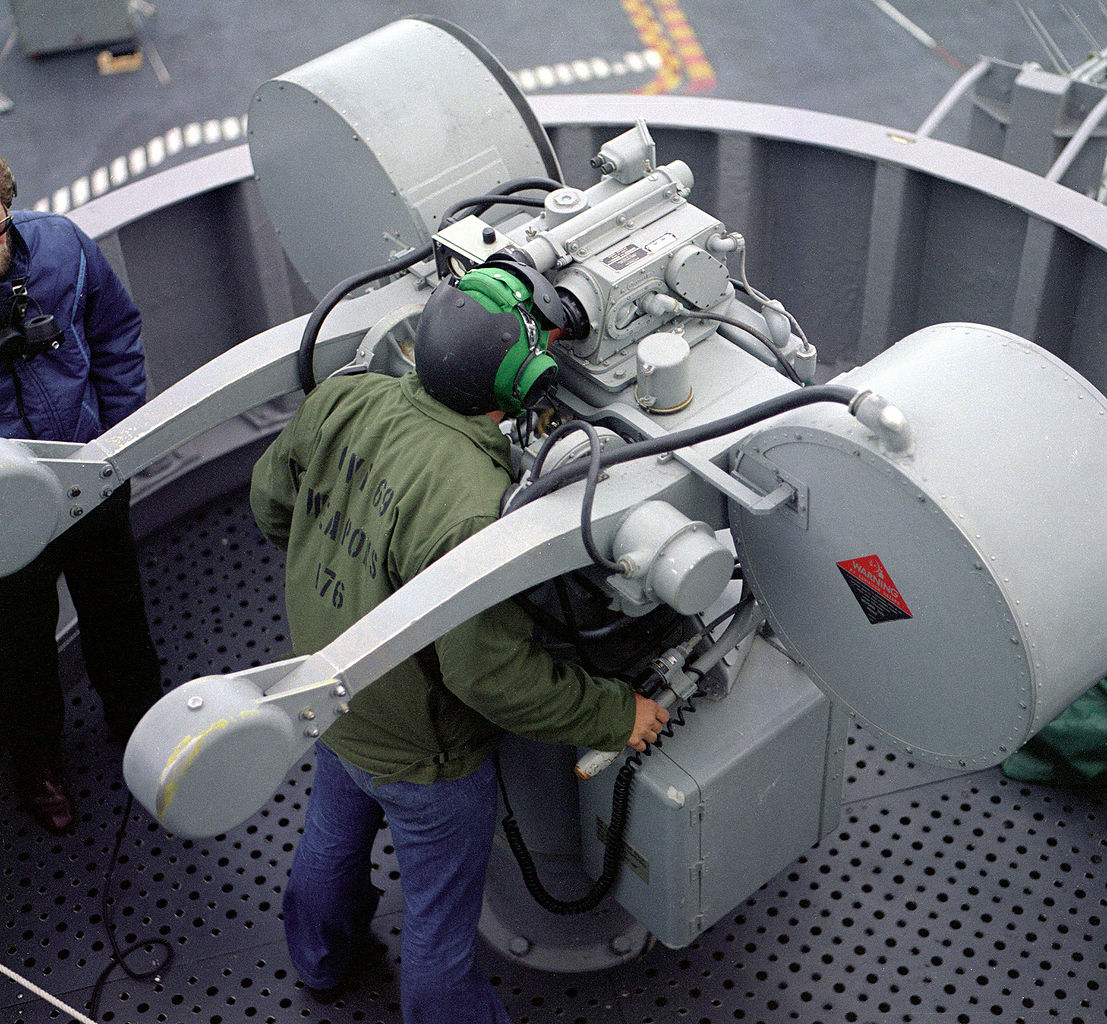
The BPDMS director in operation
But it was not without its drawbacks. The missile was equipped with modified fuzing and ECCM, but it retained the same motor as the air-launched version, which was optimized for range at high altitude from a high-speed launch platform, and was somewhat underpowered when fired from a stationary platform at sea level, limiting range to maybe 6 nm. A bigger problem was the manually-controlled guidance system, which required commands to be passed by voice, limiting response speed. A consortium of NATO nations soon joined the US in the effort to make something better, and produced what was known as NATO Sea Sparrow. This used essentially the same missile as the BPDMS, but with a far more sophisticated fire-control system, capable of automatically detecting and tracking targets, and even of engaging them automatically, subject to operator veto. The Sea Sparrow missile was also modified slightly, with the aft fins trimmed and the forward fins folding, which allowed the launcher to shrink considerably, although it continued to be an 8-round box launcher, with any additional rounds being loaded manually.2
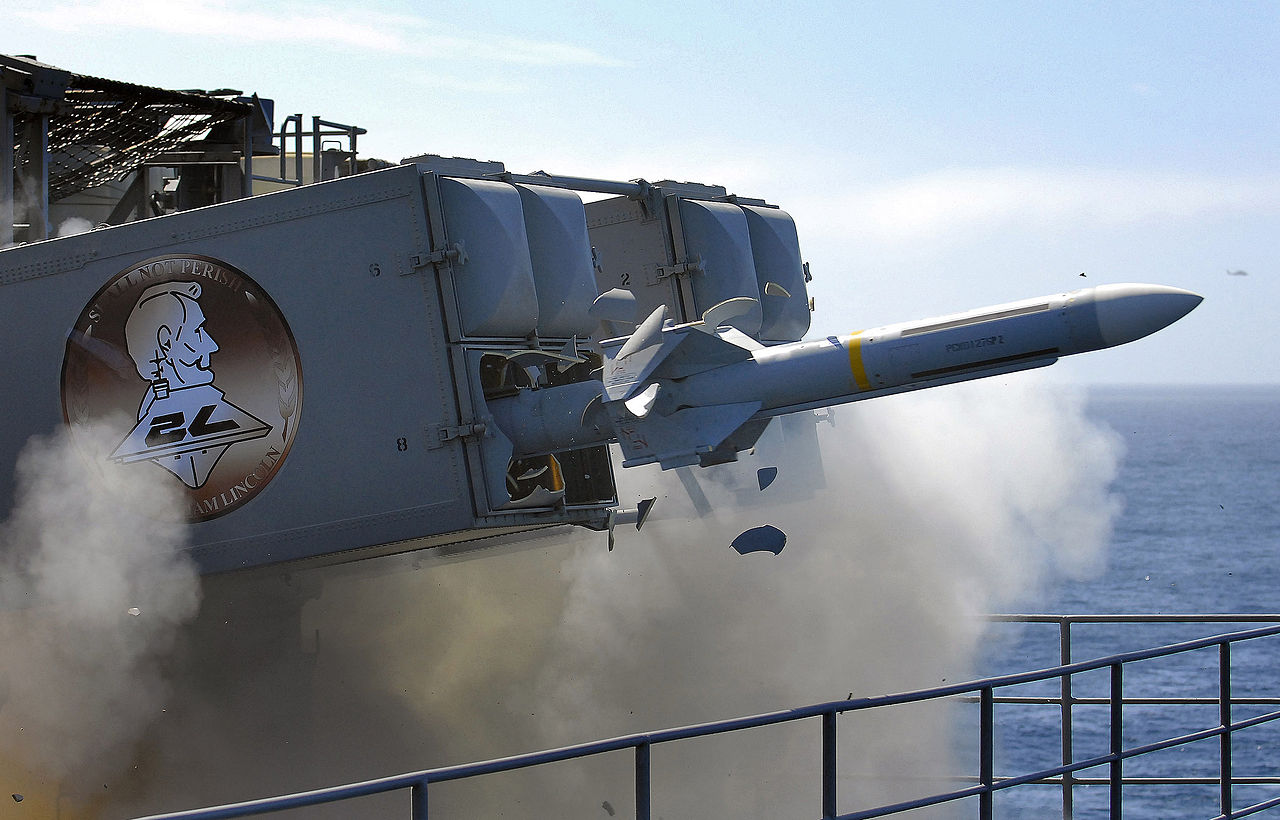
A NATO Sea Sparrow fired aboard Lincoln
In this form, the Sea Sparrow became ubiquitous among the western navies, serving with 19 different fleets, from the US and Japan to Chile and Bulgaria. The missile continued to evolve in parallel with the air-launched Sparrow, with digital guidance electronics and a better motor on the RIM-7F, and a new warhead and monopulse seeker on the RIM-7M. The RIM-7M also brought the capability to fire from the Vertical Launch System (VLS), which was beginning to enter the fleet in the mid-80s. A Jet Vane Control (JVC) unit was attached to the rear of the missile, deflecting the motor's thrust as the missile rose and turning it horizontal before it reached 200' altitude. This also required a delayed lock-on capability, as the missile couldn't observe the target until it was pointed in the right direction.
By the mid-80s, it was increasingly apparent that the air-launched Sparrow's days were numbered, with the AIM-120 AMRAAM under development to replace it. But before that happened, there would be one final version, the AIM/RIM-7P. This missile had a new programmable autopilot and a datalink which allowed the launching platform to pass updates to it in flight, much as had been done on the Standard Missile a few years earlier. This allowed the missile to fly more energy-efficient courses and get most of the way to the target before it needed illumination, greatly increasing the system's ability to handle targets in a short window. The modifications also greatly improved its ability to engage surface targets, an increasingly important consideration as the Cold War wound down.
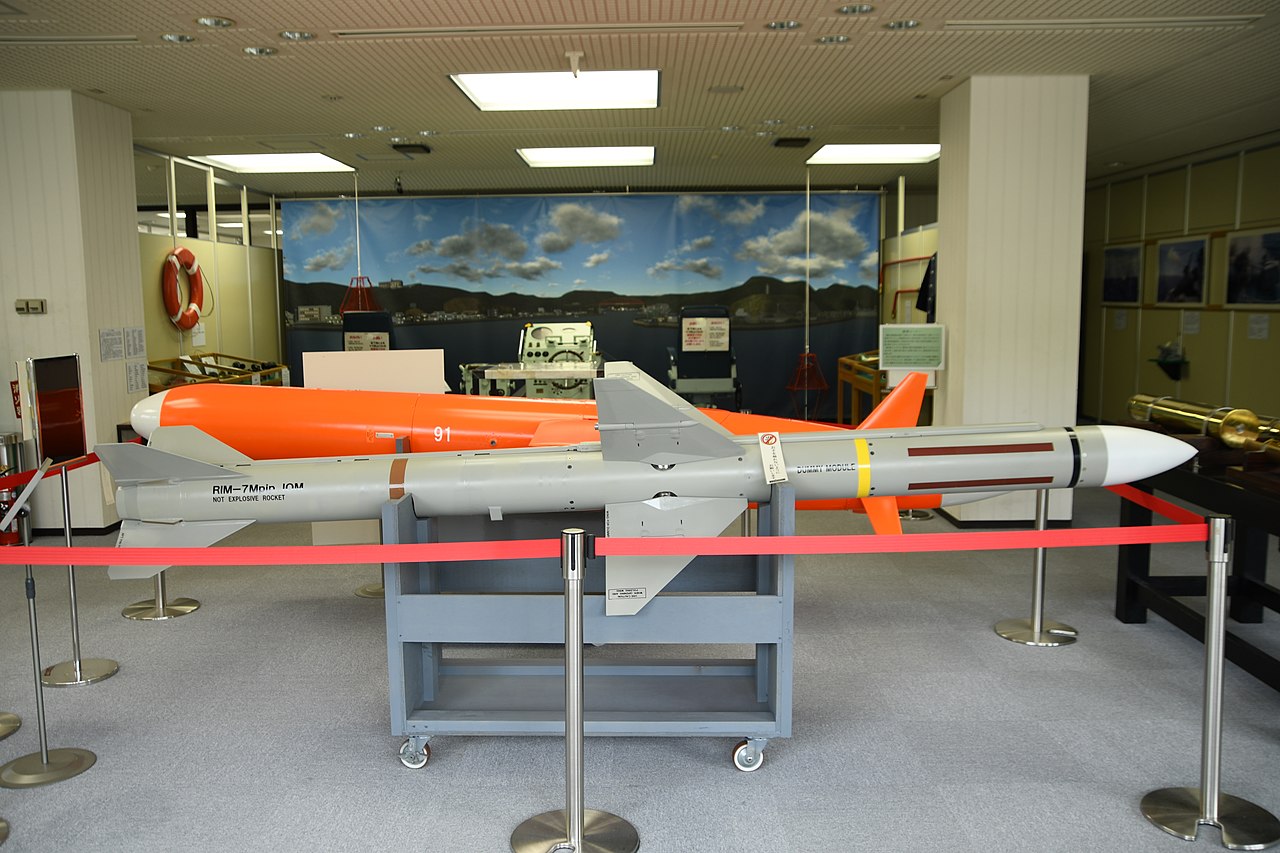
A Sea Sparrow on display
Despite a career covering nearly half a century, the original Sea Sparrow has never been fired in anger, but it has generally performed well in tests, in contrast to the reputation the air-to-air version gained over Vietnam. But that isn't to say its career has been completely uneventful. During an exercise in 1992, a series of mistakes and miscommunications resulted in the aircraft carrier Saratoga firing two Sea Sparrows at the Turkish destroyer Muavenet. The first struck the bridge, killing five officers and injuring 22, while the second hit aft, and failed to detonate. Muavenet was written off and replaced by a new frigate from the US, while the personnel responsible were disciplined.
By that point, the air-launched Sparrow was definitely dead, leaving the Navy free to pursue upgraded versions on its own. We'll take a look at where that led them next time.
1 The Navy did fit a few of these MIM-72 Chaparrals to destroyers serving off Vietnam as a stopgap anti-missile system, but it never saw wide service. ⇑
2 The only exception was the Canadian Iroquois class destroyers, which had an extremely odd 4-round rail system on each side. ⇑

Comments
Some sources claim BPDMS was impaired by night/fog, but Friedman says the illuminator radar did have a receiver.
Original British Seacat was worse - that was based on an anti-tank missile and kept the manual steering.
There's no contradiction there. Any system with a Mk I eyeball in the loop like BPDMS is going to suffer significantly from night or bad weather, even if there's also a radar mode. The radar-directed guns of WWII had similar problems. Only all-radar systems don't care.
Don't think I'll ever get over deck crew being so casual about standing on the unrailed edge of a platform cantilevered out over the ocean. Especially while wearing red shirts.
It's not that visible, but there's a catwalk below the edge of the flight deck which will probably catch anyone who falls off. You can actually see a couple of people standing in it in that photo. Places that don't have it usually have a net.
Recall the BPDM was one of those things you got working then never touched it again. Was on an FF for 18 months and never saw it turned on for anything. Maybe they did a test but never live fire or in a drill.
Same with the 5" 54. Three shots and a jam. Every-single-time.
The Muavenet story just brings up an issue that seems to be in every missile story I've ever heard: just what % of missiles fail to go off on impact. It seems like half of them.
Tangential to Sea Sparrow/BPDMS itself, what was it that moved 40mm guns from "basically worthless in the jet age" to a reasonable defense? (Looking at the Italian DARDO)
Was this purely an issue of fire control, or did something significant about the guns themselves or their ammo change too?
@Doctorpat
It's not that high. I don't recall many British fuzing failures during the Falklands, for instance. But yes, it does happen.
@Jade
Same thing that made the 20mm useful again. It's a CIWS, not a full-fledged AA system.
The Chaparral system had an entirely too long life with the ROC Navy; they ended up on their version of the French Lafayette-class frigate.